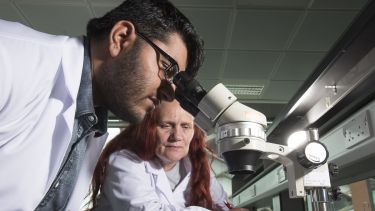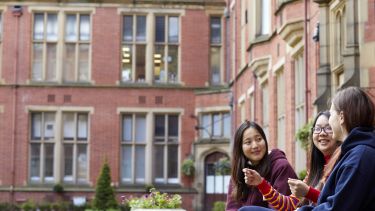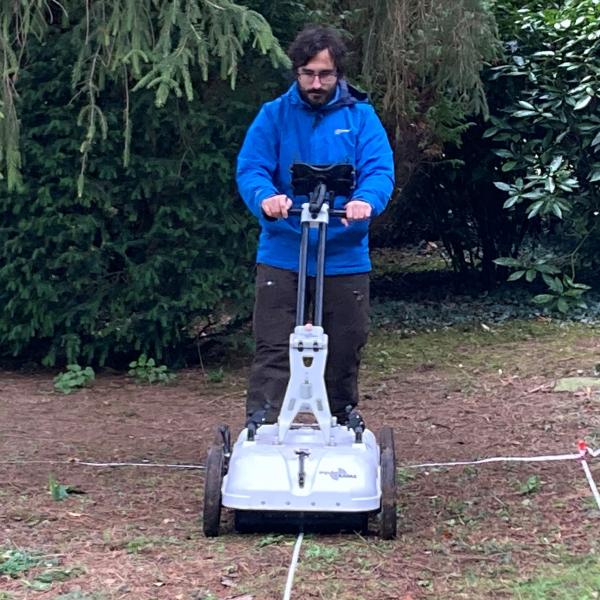Research facilities
The Department of Archaeology is home to a state-of-the-art range of scientific research facilities that complement the activities of our research clusters.

Custom-built in 2017, our cutting-edge laboratory facilities sit at the heart of our teaching and research. Through extensive bioarchaeological research collections and modern experimental equipment, we provide the ideal environment for the analysis of both organic and inorganic archaeological materials
Archaeomaterials
We have 3 designated labs where the study of archaeological materials takes place, including the experimental reconstruction of technology and the analysis of ceramics, glass and metal. We have two preparation laboratories and one microscope laboratory
-
Ceramics and lithics research
-
We have facilities within our laboratories for staff and students to manufacture and analyse petrographic thin sections. As well as two dedicated preparation laboratories allow the preparation of samples for analysis; one houses a dedicated fume cupboard rated for strong acid use. The thin sections are examined using polarising microscopy and it is possible to answer questions about provenance and manufacturing technology. Our microscope laboratory houses an extensive geological reference collection and ceramics thin section collections, which are used to gain an understanding of the mineralogical inclusions of archaeological pottery.
With a potter's wheel, kiln and a range of potter's tools within our laboratories, it is possible to experiment with pottery forming and firing of experimental vessels. By producing and analysing thin sections of experimental pottery, staff and students gain insights into the methods of manufacture and how to identify them in archaeological material.
Within the archaeological materials laboratories we have a dedicated microscope laboratory housing research-grade microscopes, as well as a laboratory containing low-temperature ovens and pottery kilns to allow the recreation and firing of ceramics.
-
Glass and metals research
-
The archaeological materials laboratories enable the research of glass and metals, with our in house range of equipment, including furnaces, lapping wheels, saws, grinders, polishers and microscopes. Here staff and students experimentally recreate archaeological glasses and metals, and can then prepare analytical samples of both archaeological and experimental materials for analysis.
Samples are analysed in-house using a range of reflected and transmitted light microscopes and through analytical equipment such as pXRF within our labs and in the field and Scanning Electron Microscopes (SEM) housed nearby in the University. The analysis allows for the manufacturing technologies employed by past societies to be investigated
-
Photogrammetry
-
Within our Microscopy and Imaging Lab we have equipment for 3D imaging and for high-resolution surface scanning. This equipment was funded through a generous donation from a graduate of the department, Peter Glover. The equipment includes two 3D3 portable structured light scanners for capturing high-resolution three-dimensional surface models, an Aribex Nomad Pro portable digital radiography set and a high quality camera with macro lens. This allows the creation of high quality photographs and 3D images of artefacts
Archaeobotany
We have a dedicated archaeobotany research area, which includes a variety of advanced microscopes for various forms of archaeobotanical research. These include stereoscopes, polarised light microscopes for pollen slides, and motorised microscopes for capturing three-dimensional imagery of plant remains. Equally important facilities are the department's extensive plant reference collections including functional ecology, wild seed and crop reference collections.
- Facilities within The Sheffield Centre for Archaeobotany and Ancient Land-Use
-
The Sheffield Centre for Archaeobotany and Ancient Land-Use has state of the art facilities for laboratory analysis and interpretation of archaeobotanical and geoarchaeological material.
Within the archaeobotany laboratory, it is possible to study charred seeds, wood charcoal, pollen, phytoliths, and starch. Our extensive seed reference collection contains a wide range of Near Eastern and European wild plants and is particularly focused on the old world crop assemblage. We also have a modern charred wood reference collection, a large pollen collection, and phytolith and starch collections. In tandem with modern reference collections, we have an up to date archaeobotany library with the key identification manuals and technical books for each type of plant remain.
Within the centre we have microscopes and equipment suited to a range of archaeobotanical analyses. There is a range of Leica stereomicroscopes in the centre for the analysis of plant macro-remains. For wood charcoal research we have a darkfield Meiji MX microscope. There are a number of transmitted light microscopes suitable for pollen and others with polarising capabilities for starch and phytolith work. For all types of plant remains the centre has image analysis equipment suitable for publication-quality photography.
Associated with the main archaeobotany lab we have a chemical lab equipped for pollen, phytolith and starch sample preparation. We also have ovens for experimental work on artificial charring and the material for the functional ecological study of plants.
As part of the centre there is a separate functional plant ecology reference collection with herbarium specimens, leaf impressions, seeds, and an ecological database.
Within the University there are SEM facilities and the possibility for plant growing experiments through co-operation with relevant departments.
Zooarchaeology
We own substantial laboratories for zooarchaeological research and teaching. In addition to the facilities and equipment, the zooarchaeology lab houses the extensive Tony Legge modern reference collection. This collection greatly facilitates all the activities undertaken by members of the lab, whether those involve research, teaching or consulting.
Contact the lab at zooarchlab@sheffield.ac.uk
Learn more about the Zooarchaeology Lab here.
- The zooarchaeology laboratory and teaching
-
The staff of the zooarchaeology laboratory are much involved in teaching activities. In particular we provide zooarchaeology teaching as part of the 3rd year undergraduate module in Archaeozoology, and the zooarchaeology modules of the MSc programmes in Osteoarchaeology and Environmental Archaeology and Palaeoeconomy.
One part of our reference collection is specifically dedicated to teaching and consists of a collection of modern and archaeological specimens, organised by body part, taxon, and other characteristics (butchery marks, gnawing, pathology etc). A collection specifically focussed on a user-friendly layout of individual teeth is currently available. Tooth identification, a difficult task for students to master, becomes much easier with the aid of a clearly labelled and laid out collection of isolated teeth of the most common species found in archaeological sites.
The teaching collection represents an essential tool for our lectures and practical sessions for both undergraduates and postgraduate students. Besides the routine use of the collection for teaching, every year the teaching and research collections are extensively used by students who undertake undergraduate, masters, or PhD dissertations in zooarchaeology.
Osteology
The Sheffield Osteology Lab was established in 1972 by eminent surgeon Judson Chesterman, and has since earned an international reputation in bioarchaeology. The lab has an extensive human skeletal reference collection for primatology and human ostealogy, comprising archaeological human bone, modern primates, teaching grade casts of modern humans and fossil hominids, and a series of longitudinal and transverse human and faunal bone thin sections.
We benefit from four dedicated lab facilities specific to the teaching of primate and human skeletal analysis including both lecture/practical spaces and research areas. On site, we also have a cutting-edge imaging suite (complete with photographic and x-ray equipment, and 3D scanning facilities), wet labs and a dedicated histology lab, plus facilities for human dissection via collaboration with the Faculty of Science.
These facilities are available to all students and staff whether as part of our taught courses, research degrees or on-going research projects. We are also happy to receive requests for access from external researchers.
Microscopy and Imaging Lab
The lab houses facilities for photogrammetry, 3D imaging and for high-resolution surface scanning and digital radiography, which are used for investigating skeletal remains and for capturing three-dimensional images of artefacts. This equipment was funded through a generous donation from a graduate of the department, Peter Glover. The equipment includes two 3D3 portable structured light scanners for capturing high-resolution three-dimensional surface models of bones and teeth as well as an Aribex Nomad Pro portable digital radiography set. Images captured with the scanning equipment are analysed on a dedicated Apple Mac Pro computer running a suite of 3D analysis software including Avizo, Geomagic Wrap and EVAN Toolbox.
This lab also features a range of microscopes and equipment for the study of archaeological materials, archaeobotany, human skeletons and zooarchaeological collections.
Our Technical Team

International undergraduate scholarships
We are offering scholarships of £2,500 for each year (subject to a 60% average) of your undergraduate degree. The maximum value is £10,000 for four-year programmes.




